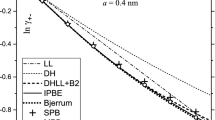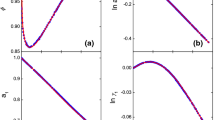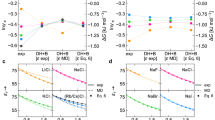Abstract
The Bjerrum association model, developed in 1926, is now incorporated in many conductance theories of electrolyte systems to extract Λ0 and K A from experimental data. The Bjerrum concept is simply a convenient way of taking into account short-range electrostatic interactions between ions. The equations of the Bjerrum model can be applied to the prediction of the temperature and pressure dependencies of K A from the value of K A at a reference T and P and from the dielectric properties of the solvent. This feature will be essential when the relaxation effect is taken into account when applying the model to heat capacities and compressibilities. These equations were tested against literature K A values (obtained from treatment of conductance data by equations that incorporate the Bjerrum concept) in aqueous electrolyte solutions at high temperatures and pressures and in some electrolyte systems in acetonitrile, 2-butanone, propylene carbonate, γ-butyrolactone, and propanol. In the absence of specific interactions in solution, the agreement between experimental and predicted K A are generally quite good. Notable exceptions are acids and bases in water, lithium perchlorate in most solvents, and the majority of electrolytes in propylene carbonate, suggesting that specific interactions in these systems may cause the model to fail.
Similar content being viewed by others
REFERENCES
N. Bjerrum, Kon. Danske Vidensk. Selskab 7, 9 (1926).
J.-C. Justice, J. Solution Chem. 20, 1017 (1991).
J.-C. Justice, J. Phys. Chem. 100, 1246 (1996).
J.-C. Justice, in Comprehensive Treatise of Electrochemistry, Vol. 5, B. E. Conway, J. O'M. Bockris, and E. Yeager, eds. (Plenum, New York, 1983), Chap. 3.
J. Barthel, R. Wachter, and H.-J. Gores, in Modern Aspects of Electrochemistry, Vol. 13, B. E. Conway and J. O'M. Bockris, eds. (Plenum, New York, 1979).
J.-F. Côté, J. E. Desnoyers, and J.-C. Justice, J. Solution Chem. 25, 113 (1996).
J.-F. Côté, G. Perron, J. E. Desnoyers, G. C. Benson, and B. C.-Y. Lu, J. Solution Chem. 27, 683 (1998).
Y. Marcus, Z. Naturforsch. 38a, 247 (1983).
P. C. Ho, D. A. Palmer, and R. E. Mesmer, J. Solution Chem. 23, 997 (1994).
P. C. Ho, and D. A. Palmer, J. Solution Chem. 24, 753 (1995).
P. C. Ho, and D. A. Palmer, J. Solution Chem. 25, 711 (1996).
D. G. Archer and P. Wang, J. Phys. Chem. Ref. Data 19, 371 (1990).
J. Barthel, R. Buchner, and H.-J. Wittmann, Z. Phys. Chem. [NF] 139, 23 (1984).
H. Graml, Thesis, Universität Regensburg, 1991.
J. Barthel, L. Iberl, J. Rossmaier, H. J. Gores, and B. Kaukal, J. Solution Chem. 19, 321 (1990).
J. Barthel, R. Neuder, M. Poxleitner, J. Seitz-Beywl, and L. Werblan, J. Electroanal. Chem. 344, 249 (1993).
M. Kindler, Thesis, Universität Regensburg, 1985.
L. Reichstädter, E. Fischerová, and O. Fischer, J. Solution Chem. 22, 809 (1993).
J. Barthel, R. Wachter, G. Schmeer, and H. Hilbinger, J. Solution Chem. 15, 531 (1986).
J.-F. Côté, D. Brouillette, J. E. Desnoyers, J.-F. Rouleau, J.-M. St-Arnaud, and G. Perron, J. Solution Chem. 25, 1163 (1996).
J. Barthel, ELDAR Data Bank, Fiz Chemie Berlin, 1990.
G. Perron, L. Couture, D. Lambert, and J. E. Desnoyers, J. Electroanal. Chem. 355, 277 (1993).
S. M. Gubskii, I. N. V'yunnik, and D. A. Nerukh, Russ. J. Phys. Chem. 65, 57 (1991).
S. L. Wellington and D. F. Evans, J. Solution Chem. 12, 815 (1983).
E. Inada, Rev. Phys. Chem. Jpn. 48, 72 (1978).
J. Everaert and A. Persoons, J. Phys. Chem. 86, 546 (1982).
Author information
Authors and Affiliations
Rights and permissions
About this article
Cite this article
Côté, JF., Perron, G. & Desnoyers, J.E. Application of the Bjerrum Association Model to Electrolyte Solutions. III. Temperature and Pressure Dependencies of Association Constants. Journal of Solution Chemistry 27, 707–718 (1998). https://doi.org/10.1023/A:1022653506593
Issue Date:
DOI: https://doi.org/10.1023/A:1022653506593




